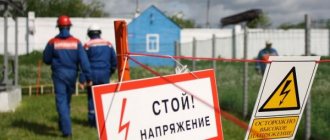Group 2 electrical safety approval is one of the first levels of technical skills and requirements for technical personnel involved in high-voltage work. Provided by a specialized organization called Rostekhnadzor, it can be assigned only after testing theory, practical knowledge and skills. Grants the right to perform a certain type of work together with another, more experienced employee. Mainly needed for welders, installers with electric tools and others.
What is it and why is it necessary?
Groups assigned to personnel are indicators of the skill, experience and personal qualities of the employee. Even administrative employees in senior positions must begin by passing a test for group 2 electrical safety clearance and obtaining a certificate and identification.
Electrical safety 2nd group of admission
Important! Only in this case can the employee be allowed to perform a certain type of work of varying complexity.
However, the first group is still the lowest, but it is not supervised. In this case, it does not require special certification by a technical supervision inspector. Electrical safety group 2 requires such assurance, and therefore is considered more preferable and important.
Almost all specialists, for example, fitters, installers, welders and even senior management specialists must first obtain this permit. In this case, you can begin to perform the required work and tasks, but only under the guidance of an employee with a higher level of access.
Also, this category allows you to work with tools and equipment that have a voltage of up to a thousand volts.
The category is issued on the basis of special testing of the theory and practice of working with electric tools. However, special certificates for a profession, for example, an assembler or a welder, are considered non-electrical, and therefore do not give the right to pick up such a tool. Therefore, such specialists need to additionally obtain a second electrical safety group. This can be called a kind of shortcoming in the legislation of the Russian Federation.
Obtaining a document confirming the availability of the second level of clearance is the first level in the career ladder of an employee whose occupation is related to electrical safety.
Technician knowledge test log
Questions and answers on electrical safety, group 2
Questions and answers on the rules for safe operation of electrical installations
1. What is called working grounding?
— Grounding at a point or points of current-carrying parts of an electrical installation, performed to ensure the operation of the electrical installation \not for electrical safety purposes\.
2. What is called protective grounding?
— Grounding for safety purposes.
3. What direct contact protection measures should be taken to protect against electric shock in normal operation?
— All of the above measures, individually or in combination. Basic insulation of live parts, fencing, installation of barriers, placement out of reach, use of ultra-low voltage.
4. What protective measures are used to protect people from electric shock due to indirect contact in the event of insulation failure?
— Protective grounding.
5. In what cases is protection from direct contact not required?
— If the equipment is located in the area of the potential equalization system, and the highest operating voltage does not exceed 25 V AC or 60 V DC in rooms without increased danger and 6 V AC or 15 V DC in all cases.
6. When should protection against indirect contact be performed?
— In all cases, if the voltage in the electrical installation exceeds 50 V AC and 120 V DC.
7. In what case can ultra-low voltage be used in electrical installations up to 1 kilovolt to protect against electric shock?
— For protection against electric shock due to direct or indirect contact in combination with protective electrical circuits or with a combination of automatic power off.
8. Which of the following can be used as natural grounding agents?
— Metal pipelines laid in the ground.
9. Which of the following cannot be used as natural grounding agents?
— metal sewer pipelines.
10. What can be used to protect against indirect contact in circuits powering portable electrical receivers?
— Any of the listed protection measures, depending on the category of the room according to the level of danger of electric shock \automatic power off, protective electrical separation of circuits, extra-low voltage, double insulation\.
11. How are grounding conductors connected to the ground electrode and grounding structures?
- Welding.
12. How is the size of the area of the grounding device subject to selective soil excavation determined?
— Decision of the consumer’s technical manager.
13. In what case should the grounding element be grounded?
— If more than 50 percent of its cross-section is destroyed.
14. Is it possible to use the ground as a phase or neutral wire in electrical installations up to 1000V?
- Not allowed.
15. Which objects are classified as special objects in terms of the degree of danger of lightning damage?
— Objects that pose a danger to the immediate environment, social and physical environment.
16. Which objects are classified as ordinary objects in terms of the degree of danger of lightning damage?
— Buildings and structures with a height of no more than 60 meters, intended for industrial trade, as well as residential and administrative buildings.
17. What structural elements of buildings and structures can be considered as natural lightning rods?
- Any elements listed above with a height of 60 meters \metal roofs, metal structures, roofs, pipes and tanks\.
18. When is the lightning protection devices of buildings, structures and external installations checked and inspected?
— Once a year before the start of the thunderstorm season.
19. When is the condition of lightning protection devices of buildings and structures of the third category checked?
- At least once every three years.
20. What protective equipment are the main insulating electrical protective equipment for electrical installations with voltages up to 1000 V?
— Insulating rods of all types, insulating clamps, voltage indicators, electrical clamps, dielectric gloves, manual insulating tools.
21. What protective equipment refers to additional insulating electrical protective equipment for electrical installations with voltages up to 1000 V?
— Dielectric galoshes, dielectric carpets, insulating stands, insulating caps, coverings and linings, ladders, insulating fiberglass stepladders.
22. What protective equipment are the main insulating electrical protective equipment for electrical installations with voltages above 1000V?
— Insulating rods of all types, insulating clamps, voltage indicators, devices and devices to ensure the safety of work during measurements when testing electrical installations, voltage indicators for checking phase coincidence, clamp-on electrical measurements, a device for piercing cables. Special protective equipment, insulating devices and accessories for work under voltage in electrical installations with voltages of 110 kilovolts and above \except for rods for transferring and potential equalization\.
23. What protective equipment refers to additional insulating electrical protective equipment for electrical installations with voltages above 1000 V?
— Dielectric gloves and boots, dielectric carpets, insulating stands, insulating caps and pads, rods for transfer and potential equalization, ladders, insulated fiberglass stepladders.
24. Under what weather conditions can insulating electrical protective devices be used in open electrical installations?
- Only in dry weather.
25. How should respiratory protective equipment be stored?
— In dry rooms in special bags.
26. From what impact should protective equipment made of rubber and polymer materials be protected?
— From exposure to acids, alkalis, oils, gasoline and other flammable substances, as well as from direct exposure to sunlight and heat radiation from heating devices no closer than one meter.
27. Is it possible to use expired protective equipment?
- Not allowed.
28. How often should periodic inspections of the presence and condition of protective equipment be carried out?
- At least once every 6 months.
29. How can an employee, during direct use, determine that electrical protective equipment has passed performance tests and is suitable for use?
— By stamp or marking on protective equipment.
30. In what electrical installations can pilot lamps be used as voltage indicators?
— The use of warning lamps is prohibited.
31. In which electrical installations do you need to wear dielectric gloves when using a voltage indicator?
— In electrical installations above 1000V.
32. How long should the voltage indicator be in direct contact with the controlled live parts when checking the absence of voltage in electrical installations with voltages up to 1000V?
- At least five seconds.
33. What are stationary voltage detectors intended for?
— To warn personnel about the presence of voltage on live parts of electrical installations.
34. In what electrical installations are voltage indicators used to check the coincidence of voltage phases\phasing\?
— In electrical installations, voltages range from 6 to 110 kilovolts.
35. What are clamp meters used for?
— To carry out any of the listed measurements:
- current measurement in circuits up to 10 kilovolts;
- measurement of voltage, current and power in electrical installations up to 1000V.
36. In what electrical installations are dielectric gloves used as the main insulating electrical protective equipment?
— In electrical installations up to 1000V.
37. How are dielectric gloves checked for punctures?
- By twisting them towards the fingers.
38. In what electrical installations are dielectric galoshes used?
— In electrical installations with voltage up to 1000V.
39. What are safety helmets used for?
- To protect against all of the above:
- protecting the head from mechanical damage;
- from water and aggressive liquids;
- from electric shock due to accidental contact up to 1000V.
40. Which of the following posters are prohibitive?
- Don’t turn it on, people are working.
41. Which of the following posters are warning signs?
— Caution, electrical voltage.
42. Which of the following posters are classified as indicative?
- Grounded.
43. What are the requirements for the appearance of dielectric carpets?
— They must have a corrugated front surface and be one color.
44. What are the requirements for insulating screwdriver shafts?
— The insulation of screwdriver shafts should end at a distance of no more than 10 millimeters from the end of the screwdriver blade.
45. What should be done first when a person is struck by an electric shock?
— As soon as possible, free the victim from the effects of electric current by turning off the nearest switch or using improvised means.
46. How should you move in the “stepping” voltage zone?
- Goose step.
47. Within what maximum radius from the point where an electric wire touches the ground can one come under “step” voltage?
- Within a radius of 8 meters.
48. In what sequence should one begin to provide first aid to victims of electric current if they are in a coma?
- Coma is no consciousness, but there is a pulse in the carotid artery. Necessary:
- make sure there is a pulse;
- turn on your stomach with support for the cervical spine;
- clean the mouth;
- apply cold to the head;
- apply bandages and splints to wounds if necessary;
- Call an ambulance.
49. If an electric shock occurs at a height, where should first aid be provided, on the ground or at a height?
— As soon as possible, lower the victim from a height to provide assistance in more convenient and safe conditions on the ground.
50. What kind of shoes should you wear in the “step tension” zone?
— In dielectric boots or galoshes.
51. In what position should the victim wait for the ambulance doctors to arrive if he is in a coma?
- Lying on your stomach, head turned to the side.
52. Rules for providing first aid if a foreign object gets into the eyes?
- Cover both eyes with a napkin and take to the first aid station.
53. Which action is not applicable when providing first aid in cases of thermal burns with damage to the integrity of the skin and burn blisters?
- Do not rinse with water or apply ice.
54. What is the minimum number of dielectric gloves that should be in switchgear with voltages up to 1000 V?
- Two pairs.
55. How many voltage indicators up to 1000V should a team servicing overhead power lines have?
- At least two.
56. How many voltage indicators should a team servicing cable lines have with them to check phase coincidence?
— Depends on local conditions.
57. How many insulating clamps for voltages up to 1000 V should be at the workplace of operational and repair personnel?
- One is enough.
58. What background should the warning sign “Caution! Electric voltage”, which is applied using a stencil to a reinforced concrete overhead line support?
— The background is the color of the surface of the concrete support.
59. What background should the warning sign “Caution! Electrical voltage”, which is mounted on the outer door of the transformers?
- Yellow.
Reason for the request by the authorities
Group 4 on electrical safety: knowledge testing, requirements for admission
The authorities of the Russian Federation are guided by the two most important documents in electrical safety:
- Rules for the technical operation of consumer electrical installations dated 2003, abbreviated as PTEEP;
- Special Order 328n of 2015.
Note! The submitted documents are the main ones when the authorities require obtaining the 2nd access group.
The most important rules for carrying out electrical work are spelled out in the Order. It contains the basic norms and requirements.
Main conclusions
Any work in electrical installations, with electrical equipment and tools, poses a potential danger and must be carried out in compliance with labor protection rules; for this purpose, certification is carried out at certain intervals to assign electrical safety group 2.
It is necessary to carry out special training of personnel, certification and registration of the entire procedure, and each stage has its own nuances, which are regulated by POTEE and must be observed in order to avoid fines.
I wish you safe and efficient work!
If you still have questions about assigning group 2 to personnel, write comments, we will discuss, and if you need help with paperwork, please contact us.
Receipt procedure
Electrical safety knowledge test
Since the second category is supervised, this means that an inspector must be personally present when obtaining permission. Some companies organize the process of obtaining a group in their own production with training and knowledge testing. In such cases, an inspector is invited.
The receiving process consists of several ways:
- personal visit and training in a special training center. It is the most optimal way to get the desired group. In this case, it is necessary to study for a month. The training program consists of performing one's own responsibilities while respecting both personal safety and the safety of others. First aid, fire safety and much more are studied. It will be useful for both experienced and novice employees to undergo training, since in this case it is possible to take a course in safe work. After completing the training and passing the internal exam, students are sent for testing to supervision;
- contacting a specialized service provider. The second method is simpler, but does not guarantee the quality of training. It is distance learning, without personal attendance at practical and theoretical classes. In this case, distance learning is carried out for a certain period of time (most often about a week). More suitable for experienced professionals who have basic safety knowledge and extensive experience working with power tools. After distance learning, a person is sent to take an official exam.
Minimum experience for each level
Procedure for assigning admission
Electrical Safety Group 4
First, if necessary, personnel are trained in courses that include at least 72 hours of theoretical and practical training.
Training in specialized courses
Upon completion of training, an exam date is set. An employee may not undergo training and prepare for certification on his own (as specified in the Rules).
Exam for assignment to group 2 in electrical safety
Certification can be carried out:
- internal commission of the organization;
- in a training center (if a Rostechnadzor inspector is included in the commission;
- at the place of registration in the Federal Service of Rostechnadzor.
The responsibilities of the head of the enterprise include appointing members of the internal commission to certify employees in electrical safety. The person responsible for electrical equipment at an enterprise is most often appointed by the chairman. Only those certified by the Rostechnadzor commission can be members of the commission. If the enterprise does not have the opportunity to create such a commission, employees undergo certification by the Rostechnadzor commission.
For your information. Knowledge testing is carried out using tickets containing tests.
In order to properly prepare for the exam, you can use special Internet services, which, in addition to tickets, contain special literature that may be useful in preparation, as well as answers to tickets. Services offer paid and free services to help prepare for certification.
Online test preparation service
Personnel who successfully pass the exams receive a standard certificate. The certificate indicates the admission group, as well as the power of the equipment with which the employee can perform work.
Important! Only after being assigned an electrical safety group is an employee allowed to perform his professional duties.
Knowledge test result
All exam results must be recorded in a standard journal.
If certification is carried out for employees of a company in the electrical engineering industry, then the results are recorded in the minutes of the meeting of TAK Rostechnadzor.
The protocol includes the date and reason for the inspection, information about the composition of the commission, information about the employee, the results of the inspection and the conclusion of the commission.
After filling out the form, the protocol is signed by all members of the commission and the certifying employee.
The certificate is valid for a year, then you must take exams again to confirm the group.
Standard certificate
When starting a job due to a transition to servicing new equipment, a change of position, etc. the employee must undergo recertification. When passing the exams, he must confirm his category in relation to servicing new equipment, working in new conditions or performing a new range of official duties.
Attention! If an employee with clearance group 2 or higher has not passed recertification on electrical safety issues, then he is treated as an employee of an enterprise with clearance group 1. If three or more years have passed between certifications, then the obtained access group is lost forever, and the employee must restore the access group, starting with the second.
Certification for compliance with access groups is not only a means of obtaining the opportunity to work with electrical installations, but also confirmation of the qualifications of the employee himself.
Requirements for those taking the test
Electrical safety group 3 up to 1000V
There are no special requirements for those wishing to obtain this level of access. It is very important to have prior electrical safety training.
Important! Pre-training must be more than 72 hours long.
Employees who work in the electrical sector can take testing without experience or education. However, there must be a first admission group. If these indicators meet, you must also meet the following requirements:
- The age of the person taking the exam must be over 18 years;
- Must have at least two months of experience working with power tools.
Appearance of the received certificate
Examination process
To pass the exam to obtain the second group, you need to know the rules and regulations on electrical safety prescribed in the relevant documents (PTEEP and Order 328n).
For employees going for testing, you should know the following:
- general rules for the construction of electrical tools, as well as rules and regulations for their operation;
- requirements for training of working personnel;
- procedure and conditions for safe work with electrical installations;
- rules for the use and testing of protective equipment and grounding during operation;
- providing medical care to people who have been injured by electric shock.
After successfully passing the test, special documents are drawn up. The chairman of the commission draws up a protocol indicating the employee’s knowledge and the timing of the next tests. The fact of assigning a group is documented, which is displayed in the journal established for this. After this, the employee receives a certificate of availability of the second electrical safety group.
Documenting
Data on passing the test is recorded in the books of Rostechnadzor and the knowledge testing journal, in which there is a special column for this. After this, the employee’s identification card is filled out.
Note! Log entries and testing reports help identify counterfeit IDs that have been acquired illegally.
If an employee received a document illegally, there will be no entries about it in the accounting journals and books. Such an employee will be considered to have failed the exam.
Requirements for employees









